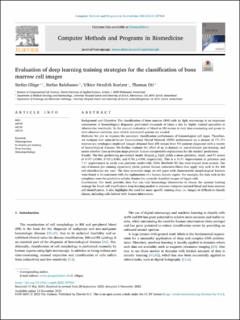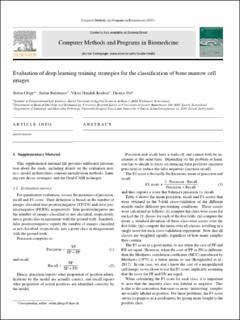Please use this identifier to cite or link to this item:
https://doi.org/10.21256/zhaw-29212| Publication type: | Article in scientific journal |
| Type of review: | Peer review (publication) |
| Title: | Evaluation of deep learning training strategies for the classification of bone marrow cell images |
| Authors: | Glüge, Stefan Balabanov, Stefan Koelzer, Viktor Hendrik Ott, Thomas |
| et. al: | No |
| DOI: | 10.1016/j.cmpb.2023.107924 10.21256/zhaw-29212 |
| Published in: | Computer Methods and Programs in Biomedicine |
| Issue: | 243 |
| Page(s): | 107924 |
| Issue Date: | 2023 |
| Publisher / Ed. Institution: | Elsevier |
| ISSN: | 0169-2607 1872-7565 |
| Language: | English |
| Subjects: | Hematopoiesis; In-domain pre-training; Deep learning; Hematopathology |
| Subject (DDC): | 006: Special computer methods 610.28: Biomedicine, biomedical engineering |
| Abstract: | Background and Objective: The classification of bone marrow (BM) cells by light mi- croscopy is an important cornerstone of hematological diagnosis, performed thousands of times a day by highly trained specialists in laboratories worldwide. As the manual evaluation of blood or BM smears is very time-consuming and prone to inter-observer variation, new reliable automated systems are needed. Methods: We aim to improve the automatic classification performance of hematolog- ical cell types. Therefore, we evaluate four state-of-the-art Convolutional Neural Net- work (CNN) architectures on a dataset of 171, 374 microscopic cytological single-cell images obtained from BM smears from 945 patients diagnosed with a variety of hema- tological diseases. We further evaluate the effect of an in-domain vs. out-of-domain pre-training, and assess whether class activation maps provide human-interpretable ex- planations for the models’ predictions. Results: The best performing pre-trained model (Regnet y 32gf) yields a mean pre- cision, recall, and F1 scores of 0.787 ± 0.060, 0.755 ± 0.061, and 0.762 ± 0.050, re- spectively. This is a 53.5% improvement in precision and 7.3% improvement in recall over previous results with CNNs (ResNeXt-50) that were trained from scratch. The out-of-domain pre-training apparently yields general feature extractors/filters that ap- ply very well to the BM cell classification use case. The class activation maps on cell types with characteristic morphological features were found to be consistent with the explanations of a human domain expert. For example, the Auer rods in the cytoplasm were the predictive cellular feature for correctly classified images of faggot cells. Conclusions: Our study provides data that can help hematology laboratories to choose the optimal training strategy for blood cell classification deep learning mod- els to improve computer-assisted blood and bone marrow cell identification. It also highlights the need for more specific training data, i.e. images of difficult-to-classify classes, including cells labeled with disease information. |
| URI: | https://digitalcollection.zhaw.ch/handle/11475/29212 |
| Fulltext version: | Published version |
| License (according to publishing contract): | CC BY 4.0: Attribution 4.0 International |
| Departement: | Life Sciences and Facility Management |
| Organisational Unit: | Institute of Computational Life Sciences (ICLS) |
| Appears in collections: | Publikationen Life Sciences und Facility Management |
Files in This Item:
| File | Description | Size | Format | |
|---|---|---|---|---|
| 2023_Gluege-etal_Deep-learning-training-strategies-classification-bone-marrow-cell-images.pdf | Article | 3.02 MB | Adobe PDF |  View/Open |
| 2023_Gluege-etal_Blood-cell-classification_Suppl.pdf | Supplementary material | 4.41 MB | Adobe PDF |  View/Open |
Show full item record
Glüge, S., Balabanov, S., Koelzer, V. H., & Ott, T. (2023). Evaluation of deep learning training strategies for the classification of bone marrow cell images. Computer Methods and Programs in Biomedicine, 243, 107924. https://doi.org/10.1016/j.cmpb.2023.107924
Glüge, S. et al. (2023) ‘Evaluation of deep learning training strategies for the classification of bone marrow cell images’, Computer Methods and Programs in Biomedicine, (243), p. 107924. Available at: https://doi.org/10.1016/j.cmpb.2023.107924.
S. Glüge, S. Balabanov, V. H. Koelzer, and T. Ott, “Evaluation of deep learning training strategies for the classification of bone marrow cell images,” Computer Methods and Programs in Biomedicine, no. 243, p. 107924, 2023, doi: 10.1016/j.cmpb.2023.107924.
GLÜGE, Stefan, Stefan BALABANOV, Viktor Hendrik KOELZER und Thomas OTT, 2023. Evaluation of deep learning training strategies for the classification of bone marrow cell images. Computer Methods and Programs in Biomedicine. 2023. Nr. 243, S. 107924. DOI 10.1016/j.cmpb.2023.107924
Glüge, Stefan, Stefan Balabanov, Viktor Hendrik Koelzer, and Thomas Ott. 2023. “Evaluation of Deep Learning Training Strategies for the Classification of Bone Marrow Cell Images.” Computer Methods and Programs in Biomedicine, no. 243: 107924. https://doi.org/10.1016/j.cmpb.2023.107924.
Glüge, Stefan, et al. “Evaluation of Deep Learning Training Strategies for the Classification of Bone Marrow Cell Images.” Computer Methods and Programs in Biomedicine, no. 243, 2023, p. 107924, https://doi.org/10.1016/j.cmpb.2023.107924.
Items in DSpace are protected by copyright, with all rights reserved, unless otherwise indicated.